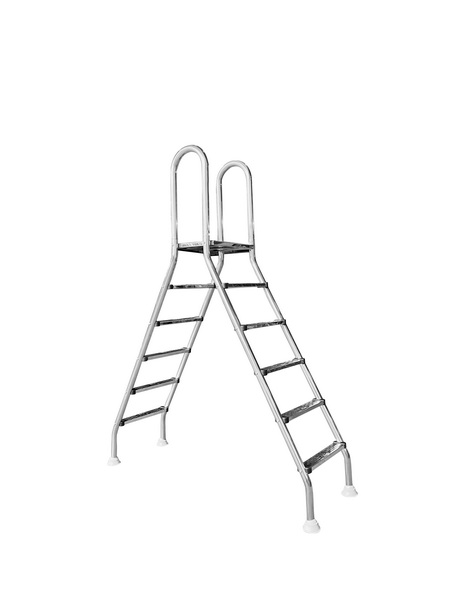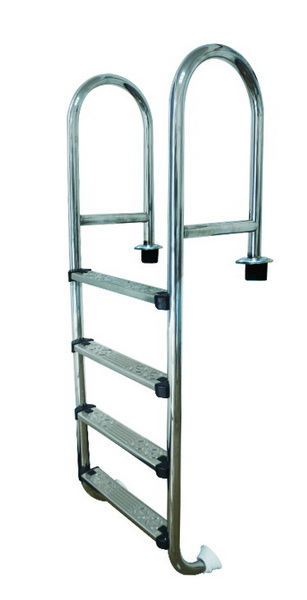Views: 222 Author: Tina Publish Time: 2025-10-17 Origin: Site








Content Menu
● Design Considerations for a Bestway-Style Pool Ladder
● Step-by-Step Assembly Guide (DIY overview)
● OEM and Sourcing Tips for International Buyers
● FAQs
>> Q1: What is the typical load capacity for pool ladders?
>> Q2: What materials resist pool chemicals and outdoor exposure?
>> Q3: Are Bestway-compatible ladders universal?
>> Q4: How do I ensure ladder safety during installation?
>> Q5: What maintenance is essential for ladder longevity?
Below is a comprehensive, thoroughly structured guide tailored for English-language readers interested in constructing or sourcing a high-quality pool ladder compatible with Bestway-style pools. We cover design considerations, materials, safety features, assembly steps, maintenance, and OEM considerations for international buyers. While this article is written for readers who may be sourcing from Chinese manufacturers, the guidance is broadly applicable to pool ladder projects and OEM workflows.

A pool ladder is a critical safety and usability component for above-ground and rectangular pools. When designing a ladder compatible with Bestway-style pools, you need to consider weight capacity, corrosion resistance, ease of installation, and secure attachment to the pool wall. This guide provides practical, actionable steps and considerations for builders, manufacturers, and brand owners who are exploring high-quality ladder solutions suitable for international markets.
- Fitment: Ensure the ladder feet and top rail align with common Bestway pool wall thicknesses and edge profiles. Consider adjustable or universal mounting brackets.
- Load Capacity: Design for adult users with a comfortable step spacing, typically 8–12 inches apart, and a total load capacity of at least 250–300 pounds (114–136 kg).
- Materials: Use corrosion-resistant metals (e.g., stainless steel) or coated aluminum for the frame, and non-slip, UV-resistant steps. Plastic components should be impact-resistant and rated for outdoor use.
- Safety Standards: Incorporate handrails, anti-slip treads, and secure fasteners to prevent wobble during use. If exporting, ensure compliance with target market standards (e.g., CE, RoHS).
- Aesthetics: Opt for sleek finishes and color options that match popular pool aesthetics while maintaining durability.
- Frame: Anodized aluminum or stainless steel frame for durability and light weight.
- Steps: Non-slip plastic or rubberized treads with texture; consider molded-in grip patterns.
- Mounting Hardware: Stainless steel screws, anchors, and brackets designed for outdoor concrete or pool wall material.
- End Caps and Seals: Weather-resistant end caps to protect against moisture ingress.
- Optional Accessories: Built-in ladder lock, anti-entrapment covers, and replaceable parts.
- Anti-Slip Surfaces: Tread texture and anti-slip coating.
- Handrails: Ergonomic grip with a non-slip surface.
- Locking Mechanisms: Secure latching to prevent accidental folding or movement.
- Smooth Edges: Rounded edges and capped bolts to minimize injury risk.
- Weight Distribution: Wide base feet to prevent sinking or rocking in soft ground.

1) Plan placement and verify wall compatibility. 2) Attach mounting brackets to the pool wall using appropriate anchors. 3) Assemble the frame on a stable surface; insert steps with anti-slip treads. 4) Secure the frame to mounting brackets, ensuring level alignment. 5) Install handrails and locking mechanisms. 6) Perform a wobble test and load test within safe limits. 7) Apply protective coatings or sealants for outdoor use.
> Tip: For international buyers, specify production tolerances and quality checks in your SOW to ensure consistent performance across batches.
- Regular Cleaning: Rinse with fresh water to remove chlorine and salt buildup.
- Inspection Schedule: Check bolts, fasteners, and handrails every 3–6 months.
- Replacement Parts: Stock common wear items like treads, end caps, and mounting hardware.
- Storage: When not in use, store in a shaded area to minimize UV degradation if not permanently mounted.
- Partner with a manufacturer that can provide end-to-end OEM services, including design, molding, finishing, and packaging.
- Request certifications and testing data for material resistance, load testing, and safety compliance.
- Seek samples and a small pilot production run before full-scale orders.
- Clarify lead times, minimum order quantities, and after-sales support.
Choosing or building a Bestway-style pool ladder requires careful consideration of fitment, materials, safety, and durability. By focusing on corrosion resistance, secure mounting, and user-friendly maintenance, you can provide a ladder solution that meets international standards and satisfies brand owners seeking OEM production partners for pool filtration systems and accessories.

A1: The typical load capacity should accommodate at least 250–300 pounds (114–136 kg) for safety, though many models target higher capacities depending on design and materials.
A2: Anodized aluminum, stainless steel, and UV-stable plastics offer good resistance to chlorine, saltwater, and UV exposure.
A3: Many ladders use common wall profiles, but compatibility varies by wall thickness and mounting system. Always confirm with the wall profile specifications before production.
A4: Use corrosion-resistant mounting hardware, secure brackets, and ensure a level, wobble-free installation. Test the ladder by applying controlled weight and simulating typical user loads.
A5: Regular cleaning, inspection of fasteners, replacement of worn treads, and protection against UV exposure and moisture are key.
This guide explains how to safely increase pressure on a pool pump by restoring healthy water flow. Learn to diagnose low pressure, clean baskets and filters, fix air leaks, adjust valves and pump speed, and know when equipment upgrades or gauge replacement are necessary.<br />
This in‑depth guide explains how much it costs to replace a pool pump, covering typical price ranges, pump types, labor charges, and long‑term energy savings. Learn when to repair vs replace, DIY vs professional options, and how OEM pump and filter solutions can reduce lifetime ownership cost.<br />
Learn exactly how long to run a pool pump daily for crystal‑clear, safe water and lower energy bills. This in‑depth guide explains turnover, seasonal adjustments, single‑ vs variable‑speed schedules, energy‑saving tips, and practical examples, plus answers to common runtime questions.
This in‑depth guide explains the real reasons your swimming pool pump is not working, from power and priming issues to clogged impellers, dirty filters, and motor failures. Learn step‑by‑step troubleshooting, key maintenance tips, and when to repair or replace your pool pump.
Learn how to remove a pool pump motor safely and efficiently with this step‑by‑step guide. Discover the tools you need, how to disconnect power and plumbing, when to call a pro, and how OEM filter and pump solutions can support overseas pool brands and wholesalers.<br />
This article introduces leading Pool Cleaning Equipment Manufacturers and Suppliers in the UK, outlines their key products, and explains how international brands can combine UK distributors with Chinese OEM factories to build competitive, high‑quality private‑label pool cleaning and filtration lines.
This article outlines the leading Pool Cleaning Equipment Manufacturers and Suppliers in America, explains key product categories such as sand filters, pumps, and robotic cleaners, and shows how importers can combine U.S. brands with Chinese OEM partners to build competitive, high‑margin pool equipment portfolios.<br />
This article introduces the European market for pool equipment and accessories, profiles key Pool Cleaning Equipment Manufacturers and Suppliers, and explores OEM opportunities for Chinese factories producing sand filters, pumps, cleaners and LEDs for European brands and wholesalers.<br />
This article profiles top Pool Filter Valve Manufacturers and Suppliers in Canada, including Praher Plastics, global brands like Hayward and Carvin, and leading distributors. It explains key valve types, buying factors, and how foreign OEM factories can partner with Canadian suppliers for complete pool filtration solutions.<br />
Discover top Pool Filter Valve Manufacturers and Suppliers in Korea, from Korea Filter to SEDA, offering innovative multiport valves, OEM services, and eco-friendly designs for global pools. Explore advancements, certifications, and FAQs in this comprehensive guide to superior filtration solutions.
This article introduces leading Pool Filter Valve Manufacturers and Suppliers in Japan and Asia, covering valve types, key Japanese pool brands, OEM opportunities, and application segments. It explains how advanced engineering, strict quality control, and strong visual marketing help exporters win global pool projects.
This article introduces the main types of Pool Filter Valve Manufacturers and Suppliers serving Russia, including local distributors, industrial filter producers, global brands, and Chinese OEM partners. It explains key selection criteria, product ranges, and OEM opportunities for Russian pool projects.<br />
This article introduces the leading Pool Filter Valve Manufacturers and Suppliers in Australia, explains common valve types and technical features, highlights major distributors and OEM opportunities, and offers practical tips for international buyers sourcing compatible filtration valves and systems.
This article introduces Italy’s leading Pool Filter Valve Manufacturers and Suppliers, detailing their technologies, materials, OEM services, and application scenarios. It explains how Italian valves integrate with sand, DE, and cartridge filters and why global brands choose Italian partners for premium pool filtration solutions.<br />
This article introduces the Portuguese market for pool filtration equipment and highlights how local specialists, European brands, and Chinese OEM Pool Filter Valve Manufacturers and Suppliers cooperate to serve residential and commercial pools, offering multiport valves, filters, pumps, and customized OEM solutions.<br />
This article explains whether you can safely use pool filter sand in an aquarium, covering sand types, preparation, pros and cons, plant and fish compatibility, maintenance tips, and alternatives. It helps hobbyists choose and manage substrate using pool-grade filtration media.
This article explains when to backwash a pool filter using pressure readings, water clarity and flow as guides. It covers sand and DE filter schedules, backwash steps, common mistakes, troubleshooting cloudy water, and how OEM sand filter systems can simplify maintenance for global pool owners.<br />
This article explains what pool filter balls are, how they work, and why they are an increasingly popular alternative to sand in residential pool filters. It covers benefits, installation, maintenance, compatibility, and OEM opportunities for brands seeking high‑performance filtration solutions.<br />
This article explains how often to change a pool filter cartridge, covering typical 1–3 year lifespans, signs of wear, and factors like usage, climate, and maintenance. It shows how cleaning frequency, pressure readings, and water clarity guide replacement and highlights the value of OEM cartridge solutions.
This article explains how often to change a pool filter cartridge, covering typical 1–3 year lifespans, factors that affect replacement timing, and clear signs of wear. It outlines cleaning versus replacement, residential vs commercial schedules, and highlights OEM cartridge solutions for complete pool filtration systems.<br />
